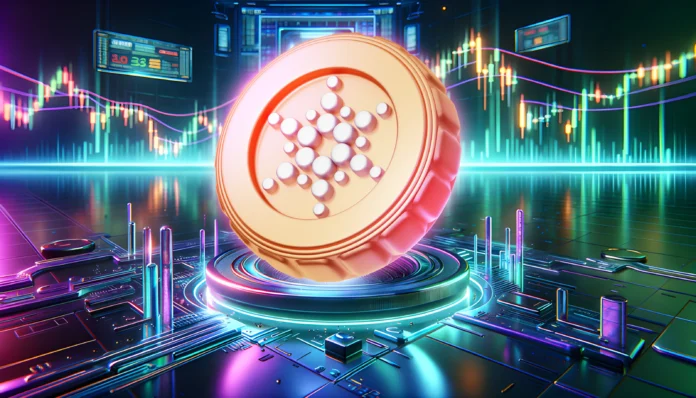Cardano has quickly become one of the most interesting entities within the blockchain/cryptocurrency space. One of many blockchains created to solve the scalability problems of the Ethereum network, Cardano has become a viable investment as well.
There are many factors that impact one’s ability to make a Cardano price prediction. In the guide below, we will look at how experts feel about Cardano’s price going into 2030, more about how the system works, and why it could stand a chance of reaching lofty predictions.
Cardano 2030 Price Prediction
Cardano’s native token, ADA, is currently trading at about $0.60 per token. Though prices fluctuate on a day-to-day basis, the most important thing that pundits and experts look at is where the token will be trading in the future.
The key is to look ahead to 2030 to have a better indication of where ADA will stand as an investment. Experts foresee a positive future for not only ADA, but the entire cryptocurrency marketplace. The outlook is bullish, some more than others.
By the time 2030 rolls around, experts feel very positively about ADA. Some predictions have it trading at more than $3.55 per token, with some feeling that it could go for more than $4.20 per token. By the end of 2030, many feel that it could be averaging more than $5.10 per token, if not more. Factors change all the time but investors feel that there will be a huge upswing in the cryptocurrency market in the coming years.
What is Cardano (ADA)?
Before investing in Cardano, it helps to know what it is. Cardano is essentially a decentralized Proof-of-Stake (PoS) blockchain. It was designed to have global use by all of its developers. The consensus is similar to Ethereum’s in that it both uses and rewards crypto for any work done when it comes to reviewing and expanding the blockchain’s historical record.
In January 2025, it made its “final phase” expansion. This allowed it to become a home for decentralized applications (dApps). These applications have several potential use cases, all of which are governed by the community. The native token, ADA, is named after Augusta Ada King, the Countess of Lovelace. She is also regarded as the first computer programmer. ADA is not only part of the Cardano blockchain, but is available to be purchased and traded on cryptocurrency exchanges and wallets as well.
How Cardano Works
At its core, Cardano is considered to be a third generation blockchain. In essence, it was created in order to solve the scalability issues that have become typical of major blockchains like Bitcoin (generation one) and Ethereum (generation two). Cardano has quickly established itself to be a source of innovation.
Earlier generations of blockchain technology were limited by low TPS (transactions per second) and high transaction fees. This has to do with inherent challenges and limitations within the design. Cardano, meanwhile, was built from the ground up in order to provide a high-TPS, low-fee, truly decentralized Proof of Stake (PoS) solution.
Because of this, it has been able to improve the capability and speed of its own network. The consensus protocol, called Ouroboros, is a focal point. Ouroboros drastically cuts down on the necessary costs of running the network without making any sacrifices to security or efficiency.
One of its latest innovations, Hydra, was designed to create theoretically infinite scalability, increasing potential throughput as every new node joins the Cardano network. The Hard Fork Combinator is another unique feature, allowing the network to hard fork without experiencing interruptions to the blockchain.
What Makes Cardano Unique?
In order to separate itself from the pack of competitors, Cardano has to do some things uniquely. One of the things that makes it unique compared to the competition is the Proof of Stake (PoS) consensus mechanism. This consensus mechanism requires far fewer energy-intensive resources, especially compared to larger platforms like Ethereum and Bitcoin.
The interesting thing is that Ethereum is in the process of making the move to PoS. This transition will take time, enough that other challenges could arise to slow its development. Cardano is already running a fully-fledged PoS network, which puts it ahead of the competition in that regard.
Cardano’s developers have also made it a point of pride to ensure that any technology developed on its platform is subject to rigorous peer-reviewed research. This means that every idea that pertains to the network will be challenged several times before they are committed to. That level of rigorous checking will ensure that the Cardano blockchain remains resilient and stable, making it easier to tackle potential issues before they are capable of becoming a problem.
As a result, the ADA token has proven to be a viable entity. The further Cardano ingratiates itself as a scalability solution, the more valuable ADA will become.
The Future for Cardano
So, what is next for Cardano? How can it take the ADA token to the next level? The future of Cardano is dependent on its ability to enhance governance and scalability. Through the implementation of solutions like CIP-1694 and Hydra, the hope is that Cardano can gain broader adoption and strengthen a stronger community.
Cardano faces inherent challenges by simply being in the cryptocurrency space. For instance, competition is as thick as ever. There are several platforms attempting to provide the same services, particularly when it comes to scalability. It also needs to demonstrate a consistent ability to handle massive transaction numbers effectively in order to compete with more prominent, faster platforms.
Finally, regulatory uncertainty will no doubt have an impact on ADA’s price. Though we are seeing greater adoption of cryptocurrency than ever before, certain platforms face larger challenges than others. As more crypto-friendly legislation is passed, it should benefit ADA’s price in the immediate future.

